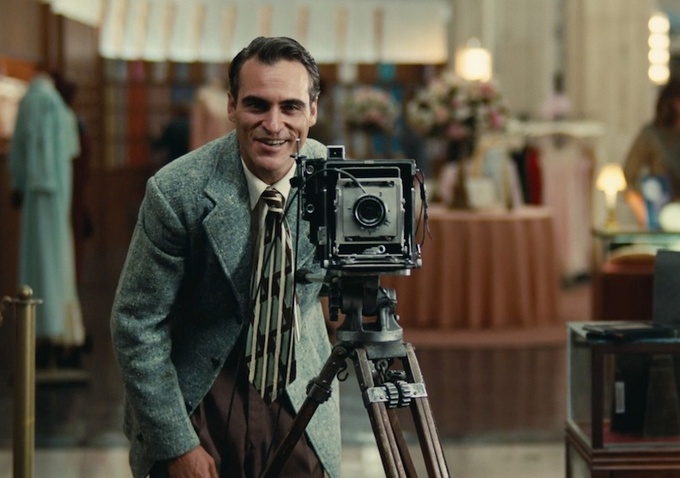by Raj Ranade
[Paul Thomas Anderson’s The Master is an oddball stunner of a movie – if you’re interested in a dazzlingly shot, brilliantly acted, deceptively complex, and occasionally baffling piece of art, I highly recommend that you see it. Rather than a conventional review, I’ve decided to put together one potential and hardly all-encompassing interpretation of what it all means. Obvious SPOILERS ahead]
The Master opens with piercing blue – the ocean trail behind a battleship, swirling and scattered into innumerable different directions. Anderson’s last film There Will Be Blood was about an American visionary, shaping the nation by steering a course into uncharted waters. His fascinating latest film is a sort of companion piece that considers the men behind those visionaries, caught in the churning, uncertain wake of iron-willed forces.
Our protagonist is Freddie Quell (Joaquin Phoenix), a Navy man adrift after the end of World War II (if it sounds like I’m hitting the nautical metaphors hard here, Anderson himself doesn’t exactly shy away from them either). Fixated on sex and fueled by booze (some is which is actual fuel – from torpedoes, specifically), Freddie can’t find a place for himself in the post-war utopia, though not for lack of trying. Five seasons of Mad Men indicate that this is hardly a novel idea, but Anderson conveys this conflict in about five minutes of stunning cinematic elegance.
In the department store where Freddie works (as a photographer, capturing Leave it to Beaver cherubs on film – like a Hollywood director portraying an ideal?), Anderson gives us a flowing tracking shot that gazes upon a salesgirl circling the room, flirtatiously hawking the mink coat and emerald dress upon her slender figure. It’s consumer culture as seductress (Ella Fitzgerald’s “Get Thee Behind Me Satan” plays in the background – a song about trying, and failing, to resist temptation).
Freddie gets her back into his darkroom, but doesn’t quite know what to do with her (a cut to their “date” is one of the year’s better sight gags) and when he later shines a light too hard on his work (literally), he’s off again in search of a cause. Circumstances soon put him with The Cause, when he sneaks aboard the yacht of Lancaster Dodd (Philip Seymour Hoffman), the leader of that religious cult (a loose analog for Scientology).
“Man is not an animal” is Dodd’s central credo, which Freddie hears on a recording as he’s scrawling a crude proposition (with the F-word and a smiley face) to a nearby girl. It initially seems that Dodd is interested in Freddie as an extreme case to be saved – the perfect future testimonial – and he puts him through talk therapy sessions called “processing”, which seek to break past Freddie’s mental defenses to purge past sins and traumas (in Freddie’s case, his lost love Doris). It’s a riveting scene as much for its content as the styles of acting that it smashes together, as Richard Brody talked about in an excellent piece. Hoffman’s Dodd is all round tones and refined charisma, a classic Hollywood capital-A Actor in the swaggering Orson Welles mold. Phoenix’s Freddie is raw and unmediated, his traumas written on his scrunched-up face and in his hunched posture – he recalls Brando or De Niro in his battle to suppress innate rage. (It’s worth noting that Burt Lancaster, a possible namesake for Dodd, was a famous opponent of Method acting of the Brando/De Niro sort.)
The thing is that this processing legitimately works towards helping Freddie with his demons – as do all of Dodd’s treatments, however seemingly random (like the segment where Dodd forces Freddie to pace between a window and a wall). Dodd may be using them to build a fraudulent financial empire around himself, based on the idea that the mind can mentally channel past lives, but that doesn’t make the methods themselves any less effective. But Freddie is searching not just for healing but for meaning – something that would elevate him above the status of a meaningless animal in a meaningless world. And as Freddie discovers what the audience has already intuited- the fact that Dodd is a charlatan – he realizes that Dodd at his core may be just as much a meaningless animal as he is.
Dodd, as it turns out, may have originally seen something of himself in the tortured old Freddie. One fantasy sequence shows that Freddie can intuit the sexual charge that Dodd seems to get out of the adoration of his female followers. His wife (Amy Adams, great if underutilized) picks up on it as well, and in their bathroom asserts her control in a way that leaves no doubt Dodd is still prey to his animal nature. And there’s an interesting scene with Freddie and Dodd temporarily in adjacent jail cells that shows how the pair are unlikely mirrors for each other – it begins with the wiry Phoenix raging in his cell while the stout Hoffman looks on, but it settles into an equilibrium of rage, and later reveals itself as a metaphor for the identical spiritual prison both men find themselves in.
Freddie ultimately can’t abide Dodd’s lies and betrayal – the fact that Hoffman has charted an artificial direction in an empty void, as in the “pick-a-point” motorcycle scene – and sets out again on his own. (There’s a nod to Easy Rider here, another film about motorcycling drifters seeking to fill a spiritual hole. That film’s tagline – “A man went looking for America and couldn’t find it anywhere” – could easily apply to The Master.) But he’s drawn back to Dodd – who, aside from being a mentor and father figure, is the one man he knows who is self-aware of his existence outside standard belief systems, and who created his own as a result. And in the final confrontation between Dodd and Freddie, we see that Anderson doesn’t judge Dodd all that harshly for doing so. In the existential void, everyone is forced to create their own belief system (one of the critical things that separates man from animal) – Dodd just happened to make a business out of it, and if he sponsored dangerous illusions, his techniques also clearly did some good.
In that final meeting, Dodd, in fact, reveals a certain envy of Freddie’s freedom – as he sings of how he’d like to get Freddie alone on a “slow boat to China”, we’re reminded that Dodd is stuck as captain of his own boat across uncharted waters, controlled now by the people (his wife, chiefly) who subscribed to his creation. This envy of freedom corresponds with some of the film’s meta-textual trappings- you have an actor of the classical Orson Welles mode trapped in a system (like the classical Hollywood system they popularized) that restricts the amount of truth he can provide – and you have the new method breed, unsatisfied with a simple Hollywood romance with Doris Day, and pushing out into new territory. And it even hints at the birth of the counter-culture – youths disillusioned with the hypocrisies of the power structure who fled from it. (Anderson’s There Will Be Blood captured America from the turn of the 20th century to the eve of the Depression, The Master spans from about 1943 to 1950, and, intriguingly enough, Anderson’s next project, an adaptation of Thomas Pynchon’s Inherent Vice, is set at the paranoid tail end of the 1960s).
Will Freddie become a counter-culture warrior? The film’s final scenes are not optimistic, as Freddie emulates his mentor’s psychological methods mainly as a parlor trick to impress women and get laid. Freddie seems unwilling to forge ahead in creating his own belief system. It seems that he’ll settle for ephemeral, sensory pleasures, equivalents of the woman made of the sand in the film’s final shot – a temporary respite from himself, soon to be torn away by the tide.









